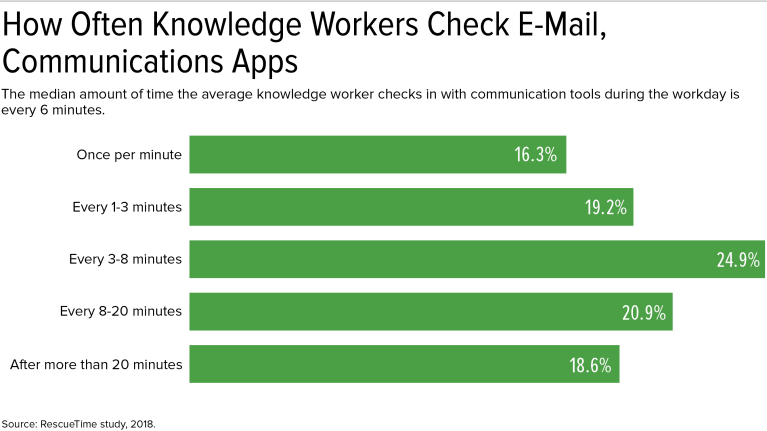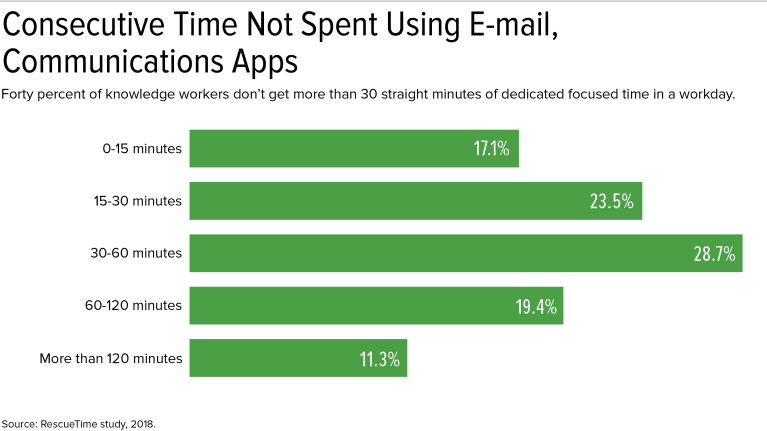It's a paradox: Digital workplace tools such as e-mail, instant messaging and collaboration software have quickened the pace of office communications, but, at the same time, they are significant obstacles to getting work done.
A recent survey of 3,750 knowledge workers conducted by Workfront, a work management software company, found that the workers are interrupted by e-mail, instant messages and other digital distractions nearly 14 times per day on average. Another survey from Adobe found that the average U.S. office worker spends more than three hours each day trying to keep up with work e-mail. And an analysis of data from 50,000 workers collected by RescueTime, a Seattle-based company that tracks digital activities, shows that the average knowledge worker checks in with communication tools every six minutes.

That study revealed that 40 minutes was the longest amount of time the average worker could go without checking e-mail during the workday. Forty percent never get 30 straight minutes of focused work time.
"Much of our most important work requires deep focus and time to think," said Robby MacDonnell, CEO of RescueTime. "Always-on communication technology demands workers respond and, in doing so, steals the precious resource of focus."

What Happens When You Lose Focus
Larry Rosen, a psychology professor at California State University, Dominguez Hills and co-author of The Distracted Mind (MIT Press, 2016), said the problem is in how the brain processes information when it is interrupted. "It takes about 20 minutes or more after processing new information to achieve total resumption of where we were before the interruption," he said.
When you add in the distractions of checking personal devices and social media, it's a wonder any work gets done at all. A 2018 survey of 1,000 office workers from online learning platform Udemy found that 36 percent of Millennials and Generation Z say they spend two hours or more checking their smartphones during the workday. Fifty-six percent of respondents said that they can't make it through the day without checking their social media, with Facebook—cited by 86 percent of respondents as a workplace distraction—far and away the top attention-getter.
Digital distractions are hurting more than worker productivity: Interruptions are taking a toll on worker well-being.
"When you are distracted or interrupted, you lose your focus, and you feel frustrated and irritated when you don't complete tasks with accuracy or completeness," said Geraldine Markel, a productivity specialist and author of Defeating the 8 Demons of Distraction: Proven Strategies to Increase Productivity and Decrease Stress (iUniverse, 2008). "Distracted workers have lower morale and loyalty and higher fatigue. People who work in a state of constant interruption report higher levels of stress."
And work colleagues are not always the culprits; a good portion of the time, our own brains are to blame, Rosen said. "Our focus and attention have been so reduced by electronic communications that we're down to a typical focus of about three to six minutes before being distracted."
He's referring to internal self-distractions, or the urge to check social media or communications channels, brought on by a biochemical need for pleasure (checking Instagram to see what family or friends are up to) or anxiety (fear of missing a message or an experience).
"These feelings are actually worse in places where employers don't allow workers to use social media or their personal phones during the workday," he said.
Defeating Distraction
The solution to the workplace concentration problem isn't removing the technology, but learning to shift how it is used, MacDonnell said. "It is time to help workers be more intentional in when and how they check communication tools. Doing so will improve not only productivity, but also employee satisfaction, as workers would feel more in command of their day."
This may require telling employees not to expect to receive instant responses to messages. Help them set realistic priorities for turnaround time, he said.
Productivity experts suggest prioritizing and batching communication into specific blocks during the day or scheduling periods of focused work without e-mail or Slack check-ins during parts of the day.
Self-auditing time spent reading and responding to e-mails and instant messages is important, said Alexandra Samuel, a researcher and writer on the business and social impact of technology.
"One way to help unlearn these reactive practices and make better use of uninterrupted periods of time is to use the Pomodoro Technique," said Brian Solis, an expert focused on understanding digital disruption and author of Lifescale: How to Live a More Creative, Productive, and Happy Life (Wiley, 2019). This method developed in the 1980s uses a timer to break down work into intervals separated by short breaks.
"The goal is to focus on a single task for 25 minutes, followed by a break of about five minutes," Solis said. "Since you know that a break is coming, it's easier to resist the urge to check each notification that pops up or become distracted by nonwork-related tasks."
Rosen outlined an alternative way to break up the day: Allow one minute to check e-mail, followed by 15 minutes of focused work, another minute to check e-mail and another 15 minutes of work. Over time, people can increase the work portion to 30 minutes and then 45 minutes. "You'll be much more productive and much less stressed," he said.
Samuel recommended setting up automation tools, such as Outlook's e-mail rules, "to triage what comes in so that the time you spend on e-mail is the most productive, and you can put your top attention to the messages which are the most important, and the rest go to alternate inboxes."
She set up a system for her business where internal e-mail went to one inbox, external e-mail to another and e-mail in which she was copied to yet another. "I told my team not to expect a response to internal communications from me until later in the afternoon so I could focus on external clients," she said. "If they needed a faster response, they had to place the word 'today' in the subject line, triggering the mail rule to send it to my prioritized inbox."
Managers need to model the desired behavior, Samuel said. "If people see the boss or team lead e-mailing at 10:30 p.m., they feel they have to, as well, and you end up with a burned-out team."
HR can help communicate that employees have the freedom to prioritize e-mail and help managers set up workshops for their teams about how to handle both internal and external messages, she said.
Additional tips for reducing digital distractions in the workplace include:
- Turning off e-mail notifications. "If you don't manage the constant attack on your sensory system, you drain mental energy and become more vulnerable to distraction," Markel said.
- Closing down e-mail, Slack, and any nonessential websites or apps for focused work periods. Put away personal devices.
- Setting up alerts to let people know you are focused on work and the best times to reach you.
- Taking short 10-minute breaks each 60 to 90 minutes. "Breaks should include activities that sweep your brain clear—taking a walk outside, exercising, talking to another person live, listening to music," Rosen said.
An organization run by AI is not a futuristic concept. Such technology is already a part of many workplaces and will continue to shape the labor market and HR. Here's how employers and employees can successfully manage generative AI and other AI-powered systems.




